Henry Stuart, Lord Darnley
Henry Stuart, Lord Darnley (7 December 1545 – 10 February 1567) was the second husband of Mary, Queen of Scots. From his marriage in 1565, he was king consort of Scotland.[2] He was created Duke of Albany shortly before his marriage. Less than a year after the birth of his and Mary's only child, King James VI of Scotland and I of England, Darnley was murdered at Kirk o' Field in 1567. Many contemporary narratives describing his life and death refer to him as Lord Darnley, his title as heir apparent to the Earldom of Lennox, and it is by this appellation that he is known in history.[3] On his mother's side he was a great-grandson of King Henry VII of England.
| Henry Stuart | |
|---|---|
 Lord Darnley in his late teens, by an unknown artist.[1] National Galleries of Scotland. | |
| King consort of Scotland | |
| Tenure | 29 July 1565 – 10 February 1567 |
| Born | 7 December 1545 Temple Newsam, Yorkshire, England |
| Died | 10 February 1567 (aged 21) Kirk o' Field, Edinburgh, Scotland |
| Burial | 14 February 1567 |
| Spouse | |
| Issue | James VI and I |
| House | Stuart (Darnley branch) |
| Father | Matthew Stewart, 4th Earl of Lennox |
| Mother | Lady Margaret Douglas |
| Religion | Catholicism |
Origins
He was the second but eldest surviving son of Matthew Stewart, 4th Earl of Lennox, by his wife Lady Margaret Douglas. Darnley's maternal grandparents were Archibald Douglas, 6th Earl of Angus, and Lady Margaret Tudor, daughter of King Henry VII of England and widow of King James IV of Scotland.
Early life
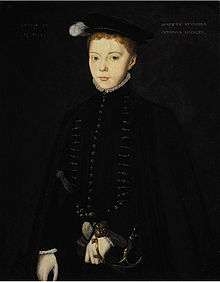
Henry Stuart, Lord Darnley, was born at Temple Newsam, Leeds, in the West Riding of Yorkshire, England, in 1545. However, this date is uncertain as his parents were not together in early 1545 and a letter of March 1566, from Mary Queen of Scots, indicates Darnley was then nineteen years old. Therefore, the date 1546 would seem probable.[5] A descendant of both James II of Scotland and Henry VII of England, Darnley had potential claims to both the Scottish and English thrones.
In 1545, his father, Matthew Stewart, 4th Earl of Lennox, was found guilty of treason in Scotland for siding with the English in the War of the Rough Wooing, in opposing Mary of Guise and Regent Arran. The family's Scottish estates were forfeited[6] and his father went into exile in England for 22 years, returning to Scotland in 1564. The Countess of Lennox Margaret Douglas, his mother, had left Scotland in 1528.[7]
The young Henry was conscious of his status and inheritance. Well-versed in Latin and familiar with Gaelic, English and French, he received an education befitting his royal lineage, and he excelled in singing, lute playing, and dancing. The Scottish scholar John Elder was among his tutors. Elder advocated Anglo-Scottish union through the marriage of Mary, Queen of Scots and Prince Edward. His advice to Henry VIII in 1543, was termed the Advice of a Redshank.[8] Another schoolmaster to the young heir was Arthur Lallart, who would later be interrogated in London for having gone to Scotland in 1562.[9] Henry was said to be strong, athletic, skilled in horsemanship and weaponry, and passionate about hunting and hawking. His youthful character is captured somewhat in a letter of March 1554 to Mary I of England from Temple Newsam, where he writes about making a map, the Utopia Nova, and his wish that "every haire in my heade for to be a wourthy souldiour".[10]
Succession crisis
Lord Darnley was the next claimant to the English throne, after the Queen of Scots, and his aging mother, and as a male, English-born Catholic, he was preferred by Elizabeth's enemies. There was a political dilemma in England arising from the dynastic ambition of the Lennoxes: Matthew Stewart, 4th Earl of Lennox, was third in line to the Scottish throne, and his wife Margaret Douglas, Countess of Lennox, was a niece of Henry VIII, making her second in line to the English throne after Mary Queen of Scots, and her son Darnley after her, should Elizabeth not have been able to accede to or hold the throne for some reason.[11] As Roman Catholics, they posed a threat to Protestant England,[11] especially in 1558, as the 25-year-old Queen Elizabeth took the throne. Although Elizabeth was bright, witty, and well-educated for her position, as a female she had to prove herself. Many Roman Catholics would have liked to have seen the next in line, the Catholic Mary, Queen of Scots, take the throne, as they regarded Elizabeth as illegitimate, her parents' marriage not having been recognised by the Catholic Church. And many would have preferred Darnley, as a male, to have the throne as well. All of these interrelationships made for complex intrigues, spying, strategising and manoeuvering for power at the various courts.
When Henry II of France died in July 1559, Lennox's brother John, 5th Sieur d'Aubigny, was elevated in the French court as kinsman of the new French queen, Mary, already Queen of Scots. Aubigny arranged for Darnley to be dispatched to the French court to congratulate Mary and Francis II of France on their accession and seek restoration for Lennox. Mary did not restore Lennox to his Scottish earldom, but she did give 1,000 crowns to Darnley and invited him to her coronation.[12] Lennox's plan was to appeal directly to the Queen of Scots via her ambassador, over the heads of Elizabeth and the Guise. The mission of Lennox's agent, one Nesbit, appears to have been a desperate one; not only was Lennox willing to hand over Darnley and his brother Charles as hostages for his restoration, but he supplied pedigrees of Darnley, indicating his right to the inheritance of England and Scotland and the houses of Hamilton and Douglas.[13] Aubigny was also later accused of supporting Mary's title to the throne of England and hinting that even his nephew had a stronger claim than Elizabeth.
Lennox set Nesbit to watch Mary, Darnley and Darnley's tutor, John Elder. In 1559 Nicholas Throckmorton, the English ambassador in Paris, warned Elizabeth that Elder was "as dangerous for the matters of England as any he knew."[14] Lord Paget in March 1560 wrote of the 'well founded' fear that Catholics would raise Darnley to the throne on Elizabeth's death.[15]
Francis Yaxley was a Catholic spy discovered in 1562 whose activities led to the arrest of the Lennox family. He had been a clerk of the Signet and from 1549 was employed by William Cecil travelling in France.[16] Yaxley was employed by the Countess of Lennox. He placed Mabel Fortescue and other ladies as servants in the Lennox household at Settrington in November 1560.[17] His interrogation at the Tower of London in February 1562 revealed that he had obtained intelligence about the English Court from the Spanish ambassador, and the ambassador had entrusted him and Hugh Allen with messages and tokens for the Lennoxes and Darnley. Yaxley admitted that his missions were intended to arrange the marriage of the Queen of Scots with Darnley, that Darnley's religion guaranteed him greater success in his suit than the Earl of Arran, and that the countess had many friends in the north.[18] Although the Lennox threat never died out, Elizabeth did not convict the family of treason in 1562 after their arrest nor did she encourage efforts to annul the countess's claim to her throne. Perhaps Elizabeth feared that these investigations could also be directed at herself, or her inaction was intended to ensure the survival of the monarchy by not reducing the number of potential heirs. The Lennox family were released in February 1563, and within a few months, Darnley and his mother were conspicuous by their presence at Court and the favour they received there, although Elizabeth would not accommodate the earl at Court.[19]
Sarah Macauley notes three outcomes of the court's decision in the Lennox trial:
"Their elevation at Court was, as it turned out in 1563, a useful complication in the succession issue. First, it presented a public statement that the preferences of Parliament (the claim of Catherine Grey in the succession crisis) could not dictate her own policy. Secondly, favouring the Lennoxes could serve as some kind of appeasement of the English Roman Catholics, who, like the Spanish ambassador, might foresee Elizabeth naming Darnley as her successor ... Such speculation would also distract them from favouring the more alarming claim of the Queen of Scots ... Thirdly, and most significantly, the elevation of the Lennoxes presented an obstacle between the Queen of Scots and the English throne. Thus was Darnley's uniquely 'British' inheritance put to use at last ... The subsequent release of Darnley into Scotland and the restoration of his father at the Scottish Court were part of this policy: the political disaster of the Darnley marriage as yet unforeseen."[20]
In September 1564, the Scottish Parliament restored Matthew Stewart's rights and titles as Earl of Lennox, and listened to a lengthy speech from the Queen's secretary William Maitland, who offered;
"[I]t may be affirmid Scotland in na manis age that presentlie levis wes in gritter tranquillitie."[21]
Marriage to Mary, Queen of Scots
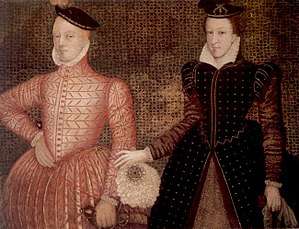
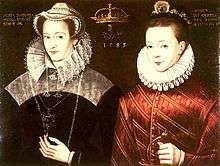
On 3 February 1565, Darnley left London and by 12 February, he was in Edinburgh. On 17 February, he presented himself to Mary at Wemyss Castle in Fife. James Melville of Halhill reported that "Her Majesty took well with him, and said that he was the lustiest and best proportioned long man that she had seen."[23] After a brief visit to his father at Dunkeld, Darnley returned with Mary and the court to Holyrood on 24 February. The next day, he heard John Knox preach, and he danced a galliard with Mary at night. From then on, he was constantly in Mary's company.[2]
Darnley was his wife's half-first cousin through two different marriages of their grandmother, Margaret Tudor, putting both Mary and Darnley high in the line of succession for the English throne. Darnley was also a descendant of a daughter of James II of Scotland, and so also in line for the throne of Scotland.
As a preliminary to the marriage, Darnley was made Lord of Ardmanoch and Earl of Ross at Stirling Castle on 15 May 1565. An entourage of 15 men were made knights, including one of Mary's half brothers, Robert Stewart of Strathdon, Robert Drummond of Carnock, James Stewart of Doune Castle, and William Murray of Tullibardine.[24] In England, a concerned Privy council debated the perils of the intended marriage on 4 June 1565. One of their resolutions was to relax the displeasure shown to Lady Catherine Grey, another rival to Mary Stuart for the English throne.[25] Mary sent John Hay, Commendator of Balmerino, to speak to Elizabeth; Elizabeth demanded Darnley's return, and gave John Hay plainly to understand her small satisfaction.[26]
On 22 July, Darnley was made Duke of Albany in Holyrood Abbey, and the banns of marriage were called in the parish of Canongate. A proclamation was made at the Cross of Edinburgh on 28 July that government would be in the joint names of the king and queen of Scots, thus giving Darnley equality with, and precedence over, Mary. This was confirmed in the circulation of a silver ryal in the names of Henry and Mary.[27][28]
On 29 July 1565, the marriage took place by Roman Catholic rites in Mary's private chapel at Holyrood, but Darnley (whose religious beliefs were unfixed – he was raised as a Catholic, but was later influenced by Protestantism)[29] refused to accompany Mary to the nuptial Mass after the wedding itself.[2]
Estrangement
Soon after Mary married Darnley, she became aware of his vain, arrogant and unreliable qualities, which threatened the wellbeing of the state. Darnley was unpopular with the other nobles and had a violent streak, aggravated by his drinking.[3] Mary refused to grant Darnley the Crown Matrimonial, which would have made him the successor to the throne if she died childless.[29] By August 1565, less than a month after the marriage, William Cecil heard that Darnley's insolence had driven Lennox from the Scottish court. Mary soon became pregnant.
Mary's private secretary, David Rizzio, was stabbed 56 times on 9 March 1566 by Darnley and his confederates, Protestant Scottish nobles, in the presence of the queen, who was six months pregnant. According to English diplomats Thomas Randolph and the Earl of Bedford, the murder of Rizzio (who was rumoured to be the father of Mary's unborn child) was part of Darnley's bid to force Mary to cede the Crown Matrimonial. Darnley also made a bargain with his allies to advance his claim to the Crown Matrimonial in the Parliament of Scotland in return for restoring their lands and titles.[30]
When the Spanish Ambassador in Paris heard this news, the headlines were that Darnley "had murdered his wife, admitted the exiled heretics, and seized the kingdom." However, on 20 March, Darnley posted a declaration denying all knowledge of or complicity in the Rizzio murder. Mary no longer trusted her husband, and he was disgraced by the kingdom. On 27 March, the Earl of Morton and Lord Ruthven, who were both present at Rizzio's murder and had fled to England, wrote to Cecil claiming that Darnley had initiated the murder plot and recruited them, because of his "heich quarrel" and "deadly hatred" of Rizzio.[31]
Birth of son
Mary and Darnley's son James (the future King James VI of Scotland and I of England) was born on 19 June 1566 at Edinburgh Castle.[33] He was baptised Charles James on 17 December 1566 in a Catholic ceremony held at Stirling Castle.[34] His godparents were Charles IX of France,[35] Elizabeth I of England[36] and Emmanuel Philibert, Duke of Savoy.[35] Mary refused to let the Archbishop of St Andrews, whom she referred to as "a pocky priest", spit in the child's mouth, as was then the custom.[3] In the entertainment, devised by Frenchman Bastian Pagez, men danced dressed as satyrs and sporting tails; the English guests took offence, thinking the satyrs "done against them".[3]
Following the birth of James, the succession was more secure, but Darnley and Mary's marriage continued to struggle.[34] Darnley, however, alienated many who would otherwise have been his supporters through his erratic behavior. His insistence that he be awarded the Crown Matrimonial was still a source of marital frustration.[37]
Death
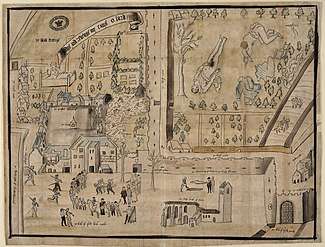
Darnley was murdered eight months after James' birth. On the night of 9–10 February 1567, his body and that of his valet were discovered in the orchard of Kirk o' Field, in Edinburgh, where they had been staying.[38]
During the weeks leading up to his death, Darnley was recovering from a bout of smallpox (or, it has been speculated, syphilis). He was described as having deformed pocks upon his face and body. He stayed with his family in Glasgow, until Mary brought him to recuperate at Old Provost's lodging at Kirk o' Field, a two-story house within the church quadrangle, a short walk from Holyrood, with the intention of incorporating him into the court again.[39] Darnley stayed at Kirk o' Field while Mary attended the wedding of Bastian Pagez, one of her closest servants, at Holyrood. Around 2 A.M. on the night of 9–10 February 1567, while Mary was away, two explosions rocked the foundation of Kirk o' Field. These explosions were later attributed to two barrels of gunpowder that had been placed in the small room under Darnley's sleeping quarters. Darnley's body and the body of his valet William Taylor were found outside, surrounded by a cloak, a dagger, a chair, and a coat. Darnley was dressed only in his nightshirt, suggesting he had fled in some haste from his bedchamber.
Darnley was apparently smothered.[40] There were no visible marks of strangulation or violence on the body.[41] A post-mortem revealed internal injuries, thought to have been caused by the explosion. John Knox claimed the surgeons who examined the body were lying, and that Darnley had been strangled, but all the sources agree there were no marks on the body and there was no reason for the surgeons to lie as Darnley was murdered either way.[42]
Aftermath
Suspicion quickly fell on the Earl of Bothwell and his supporters, notably Archibald Douglas, Parson of Douglas, whose shoes were found at the scene, and on Mary herself. Bothwell had long been suspected of having designs on the throne, and his close relationship with the queen gave rise to rumours they were sexually intimate. This was viewed as a motive for Bothwell to have Darnley murdered, with help from some of the nobility and seemingly with royal approval. Mary had been looking at options for removing Darnley, though her ideas were for divorce, and none were suitable.
Soon after Darnley's death, Bothwell and Mary left Edinburgh together. There are two points of view about the circumstances: in the first, Bothwell kidnapped the queen, took her to Dunbar Castle, and raped her. In the second, Mary was a willing participant in the kidnapping, and the story of rape was a fabrication, so her honour and reputation were not ruined by her marriage to a man widely suspected of murder. Mary later miscarried twins by Bothwell.
Suspicions that Mary colluded with conspirators in her husband's death or that she took no action to prevent his death were key factors in the downward spiral that led to her loss of the Scottish crown. The Casket letters, alleged to have been written by Mary, seemed to indicate her support for the killing. The letters were purportedly found by James Douglas, 4th Earl of Morton, in Edinburgh in a silver box engraved with an F (supposedly for Francis II), along with a number of other documents, including the Mary-Bothwell marriage certificate.[43] Before Morton's execution in 1581, he admitted having knowledge of the murder plot, and that Bothwell and Archibald Douglas were "chief actors" in Darnley's murder.[44]
A soldier under the pay of Bothwell, William Blackadder of the Clan Blackadder, was allegedly the first non-participant to happen upon the scene, and for that reason was treated as a suspect. Although initially cleared of any involvement in the murder, he was offered up by the conspirators and convicted at a show trial, after which he was executed by being hanged, drawn and quartered before each of his limbs was nailed to the gates of a different Scottish town.
Bothwell was put on trial in Edinburgh and found not guilty. In 1568 Mary's involvement in the murder was discussed in England in conferences at Yoerk and Westminster which ended with no definitive findings. Mary was kept in captivity until she was implicated in the Babington plot against Elizabeth, after which she was convicted of treason and executed.[45]
Burial and missing remains
Darnley was buried in the Royal Vault in Holyrood Abbey in 1567 alongside the bodies of several royals: King David II, King James II, Arthur, Duke of Rothesay, Madeleine of Valois, James, Duke of Rothesay, Arthur, Duke of Albany and King James V. In 1668 the vault was opened by mobs and sometime later between 1776–8 the vault was raided and the skull of Lord Darnley stolen.[46]
In 1928 a paper was published by Karl Pearson,[47] detailing his vast research into the skull of Lord Darnley. In his paper, Pearson discussed the possibility of Darnley's skull residing in the Royal College of Surgeons’ museum. In 2016 at the request of the University of Edinburgh research was undertaken to identify whether a skull in the University's collection could be Darnley's stolen remains. Pearson's skull and the University's were examined and compared to portraits of Darnley by Emma Price at the University of Dundee. The conclusion was that the Edinburgh skull could not be Darnley's, but the Royal College of Surgeons' one (which had been destroyed in the Blitz) was a good match. A historical facial reconstruction was then produced.[38][48]
Titles, styles, honours and arms
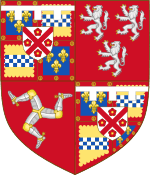
Titles and styles
- 7 December 1545 – 15 May 1565: Lord Darnley and Master of Lennox
- 15 May – 20 July 1565: The Earl of Ross and Lord of Ardmanach.[49]
- 20–28 July 1565: The Duke of Albany
- 28 July 1565 – 10 February 1567: His Grace The King of Scots
Honours
- February 1565: Order of Saint Michael, awarded by King Charles IX of France.[50]
In popular culture
- Douglas Walton played the part of Lord Darnley in the 1936 film Mary of Scotland, directed by John Ford and starring Katharine Hepburn and Fredric March.
- Axel von Ambesser played the part of Lord Darnley in the 1940 film Das Herz der Königin.
- Timothy Dalton played the part of Darnley in the 1971 film Mary, Queen of Scots, starring Vanessa Redgrave. Darnley is portrayed as a snivelling, pathetic character who marries Mary as part of a plot by Elizabeth I (Glenda Jackson) to weaken Mary's claim to the English throne. Dalton portrays Darnley as a pampered, spoiled man who beds the Queen's advisor, David Rizzio (Ian Holm), but later falls out with Rizzio and has him murdered by other plotters (referred to in the film as the Lords of the Congregation). Darnley then mourns the death of his former lover. A plot to murder Darnley is later planned and carried out by Lord Bothwell (Nigel Davenport), Mary's illegitimate half-brother Lord Moray (Patrick McGoohan), and the various Scottish Lords who participated in the murder of Rizzio (Huntly, Morton, Falconside, and others). The plot is depicted in the film as having Mary's tacit approval.
- Rizzio's murder at Holyroodhouse is also a crucial plot point in The Italian Secretary, a Sherlock Holmes-pastiche by Caleb Carr.
- The years of Darnley's marriage to Mary, including the murder of David Rizzio and Darnley's subsequent suspicious death, are covered in Jesse Blackadder's historical novel, The Raven's Heart, HarperCollins (Australia) Pty (2011)
- On the highly fictionalized CW television show Reign, which first aired on 13 October 2013, Will Kemp played the part of Lord Darnley. His version of the character is arrogant, manipulative, and hot-headed with ambitions for the crowns of both Scotland and England. His ambitions are complicated, however, by latent affection for a past love and Mary's distrust of him.[51]
- Darnley is the protagonist of Steven Veerapen's novel, The Queen’s Consort (Sharpe Books, 2018). Darnley is portrayed as seeking the Scottish crown to free his mother from Elizabeth I's captivity in the Tower of London. The novel covers Darnley's life from 1563 until his death in 1567, during which he lived at Elizabeth's court and then Mary's.
- Jack Lowden played Darnley in the 2018 film Mary Queen of Scots. Closely following the 1971 film, Darnley is shown as weak, alcoholic, and homosexual; as in the earlier film, he has sex with the Queen's advisor, David Rizzio (Ismael Cruz Córdova).
Ancestry
| Ancestors of Henry Stuart, Lord Darnley | |||||||||||||||||||||||||||||||||||||||||||||||||||||||||||||||||||||||||||||||||||||||||||||||||||||||||||||||||||||||||||||||||||||||||||||||||||||||||||||||||||||||||||||||||||||||||||||||||||||||||||||||||||||||||||||||||||||||||||||||||||||||||||||||||||||||||||||||||||||||||
|---|---|---|---|---|---|---|---|---|---|---|---|---|---|---|---|---|---|---|---|---|---|---|---|---|---|---|---|---|---|---|---|---|---|---|---|---|---|---|---|---|---|---|---|---|---|---|---|---|---|---|---|---|---|---|---|---|---|---|---|---|---|---|---|---|---|---|---|---|---|---|---|---|---|---|---|---|---|---|---|---|---|---|---|---|---|---|---|---|---|---|---|---|---|---|---|---|---|---|---|---|---|---|---|---|---|---|---|---|---|---|---|---|---|---|---|---|---|---|---|---|---|---|---|---|---|---|---|---|---|---|---|---|---|---|---|---|---|---|---|---|---|---|---|---|---|---|---|---|---|---|---|---|---|---|---|---|---|---|---|---|---|---|---|---|---|---|---|---|---|---|---|---|---|---|---|---|---|---|---|---|---|---|---|---|---|---|---|---|---|---|---|---|---|---|---|---|---|---|---|---|---|---|---|---|---|---|---|---|---|---|---|---|---|---|---|---|---|---|---|---|---|---|---|---|---|---|---|---|---|---|---|---|---|---|---|---|---|---|---|---|---|---|---|---|---|---|---|---|---|---|---|---|---|---|---|---|---|---|---|---|---|---|---|---|---|---|---|---|---|---|---|---|---|---|---|---|---|---|---|---|---|
| |||||||||||||||||||||||||||||||||||||||||||||||||||||||||||||||||||||||||||||||||||||||||||||||||||||||||||||||||||||||||||||||||||||||||||||||||||||||||||||||||||||||||||||||||||||||||||||||||||||||||||||||||||||||||||||||||||||||||||||||||||||||||||||||||||||||||||||||||||||||||
References
- PG 2279, www.nationalgalleries.org
- Elaine Finnie Greig, 'Stewart, Henry, duke of Albany [Lord Darnley] (1545/6–1567)', Oxford Dictionary of National Biography, Oxford University Press, 2004; online edn, Jan 2008 accessed 4 March 2012
- Mary Queen of Scots, by Antonia Fraser, 13th reprint, London: 1989; ISBN 0-297-17773-7
- Henry Stuart, Lord Darnley, 1545–1567. PG 2471, www.nationalgalleries.org
- Weir, Alison (2015). The Lost Tudor Princess: The Life of Lady Margaret Douglas. New York: Ballantine Books. p. 131. ISBN 9780345521392.
- Elaine Finnie Greig, 'Stewart, Henry, duke of Albany [Lord Darnley] (1545/6–1567)', Oxford Dictionary of National Biography, Oxford University Press, 2004; online edn, Jan 2008
- Daniel, William S. (1852), History of The Abbey and Palace of Holyrood. Pub. Edinburgh: Duncan Anderson. p. 62
- Letters & Papers Henry VIII, vol. 18 part 2, (1902), no. 539: Bannatyne Miscellany, Edinburgh vol. 1, (1827), 1–6
- Calendar State Papers Domestic 1547–1580, (1856), pp. 201, 203
- Ellis, Henry, ed., Original Letters illustrative of British History, 2nd series vol. 2, (1827) pp. 249–251
- Macauley, (2004), p. 267
- Macauley, (2004), p. 268
- Macauley, (2004), pp. 268–269
- Calendar State Papers Foreign Elizabeth, vol. 1
- The Lennox Crisis, 1558–1563; Sarah Macauley, Christ's College, Cambridge. Northern History, 41:2 (Sept. 2004), p. 276.
- HMC Manuscripts of the Marquis of Salisbury, vol. 1 (London, 1883), pp. 74, 118, 121, 147; vol. 2 (1888), p. 509: CSP Domestic, Elizabeth: 1547–1580 (London, 1856), p. 90.
- CSP Domestic, Elizabeth: 1547–1580 (London, 1856), pp. 164, 171, 177.
- Macauley, (2004), p. 284: CSP Domestic 1547–1580 (London, 1856), p. 195.
- Macauley, (2004), p. 287
- Macauley, Sarah. 'The Lennox Crisis, 1558–1563.', in Northern History 41.2 (2004), pp. 267–287
- Cameron, Annie I., ed., Warrender Papers, vol. 1 (Edinburgh, 1931), p. 43, Maitland's oration in parliament.
- "Henry Stuart, Lord Darnley, (1545–1567) and Mary, Queen of Scots (1542–1587), National Trust Inventory Number 1129218". National Trust collections. Archived from the original on 4 February 2014. Retrieved 2 February 2014.
- Melville, James (1973). Gordon Donaldson (ed.). Memoirs of his own life. New York: AMS Press. ISBN 0404527183.
- Goodare, Julian, 'Queen Mary's Catholic Interlude', in Mary Stewart Queen in Three Kingdoms: Innes Review, vol.37 (1987), p. 158: Calendar of State Papers Scotland, vol. 2 (Edinburgh, 1900), p. 161 no. 181.
- Calendar State Papers Scotland, vol. 2 (Edinburgh, 1900), pp. 175, 194.
- Calendar of State Papers Scotland, vol. 2 (Edinburgh, 1900), pp. 175–177, 178.
- Calendar State Papers Scotland, vol. 2 (Edinburgh, 1900), p. 184.
- Daniel, William S. (Edinburgh, 1852), History of The Abbey and Palace of Holyrood, p. 67.
- Davison, Meredith Henry Armstrong, The Casket Letters 1965.
- Calendar State Papers Scotland, vol.2 (1900), pp.259–61 no.351, 6 March 1566, or so Randolph and Bedford were advised before the murder.
- Calendar State Papers Scotland, vol.2 (1900), 270–1 no.364 & no.369.
- "The Darnley Sycamore". Forestry Commission Scotland – Heritage Trees of Scotland website. Archived from the original on 15 February 2009. Retrieved 10 February 2009.
- "BBC – History – James I and VI". Retrieved 20 September 2018.
- Stewart, Alan (31 October 2011). The Cradle King: A Life of James VI & I. Random House. ISBN 9781448104574.
- Weir, Alison (18 December 2007). Mary, Queen of Scots, and the Murder of Lord Darnley. Random House Publishing Group. ISBN 9780307431479.
- Murdoch, Steve (2006). Network North: Scottish Kin, Commercial And Covert Associations in Northern Europe 1603–1746. BRILL. ISBN 9004146644.
- Walton, K. (28 November 2006). Catholic Queen, Protestant Patriarchy: Mary Queen of Scots and the Politics of Gender and Religion. Springer. ISBN 9780230285958.
- Knapton, Sarah (August 2016). "Face of Lord Darnley revealed – Mary Queen of Scots' 'lusty and well proportioned' husband". The Telegraph. Retrieved 6 September 2017.
- "Mary, Mary, quite Contrary." Off Our Backs 19 February 1971: 11-. ProQuest Research Library. Web. 15 Mar 2012 .
- Weir 2008, p. 296; Wormald 1988, p. 161
- Weir 2008, p. 252; Greig 2004
- Weir 2008, p. 255
- MacRobert, A. E. (2002). Mary, Queen of Scots and the casket letters. International Library of Historical Studies. 25. I.B.Tauris. ISBN 978-1-86064-829-8.
- The Skull and Portraits of Henry Stewart, Lord Darnley, and their Bearing on The Tragedy of Mary, Queen of Scots Karl Pearson Biometrika , Vol. 20B, No. 1 (Jul. 1928), pp. 1–104
- "CATHOLIC ENCYCLOPEDIA: Mary Queen of Scots". Newadvent.org. 1 October 1910. Retrieved 9 September 2012.
- Wilson, Daniel (1890). "Queen Mary and the legend of the black turnpike" (PDF). The Society of Antiquaries of Scotland. XXIV: 415–435 – via Archaeology Data Service.
- Pearson K (1928) The skull and portraits of Henry Stewart, Lord Darnley, and their bearing on the tragedy of Mary, Queen of Scots. Biometrika 20: 1–104
- Price, Emma (2016). "Lord Darnley". Forming Faces.
- Daniel, William S. (1852), History of The Abbey and Palace of Holyrood. Pub. Edinburgh: Duncan Anderson, p. 65.
- Anderson, Duncan (1849). History of the Abbey and Palace of Holyrood. Edinburgh, Scotland: Keeper of the Chapel Royal. p. 58. Archived from the original on 15 December 2011. Retrieved 15 December 2011.
about the beginning of February 1565-6, the Seigneur de Rembouillet, with a deputation from the King of France, arrived at the Palace, to present Darnley with the order of St. Michael, known as the Scallop or Cockle-shell Order, so called from the escallop shells of which the collar was composed. The investiture was performed after the celebration of mass in the Chapel-Royal
- https://www.imdb.com/title/tt2710394/fullcredits?ref_=tt_cl_sm#cast
Bibliography
| Wikimedia Commons has media related to Henry Stuart, Lord Darnley. |
- Darnley: A Life of Henry Stuart, Lord Darnley, Consort of Mary Queen of Scots by Caroline Bingham
- Macauley, Sarah, 'Lennox Crisis', in Northern History vol.41.2 (2004) subscription or ATHENS login required.
- Greig, Elaine Finnie (2004). "Stewart, Henry, duke of Albany [Lord Darnley] (1545/6–1567)". Oxford Dictionary of National Biography. 1. Oxford University Press. doi:10.1093/ref:odnb/26473. Retrieved 3 March 2012.CS1 maint: ref=harv (link) (subscription or UK public library membership required)
- Weir, Alison (2008) [2003]. Mary, Queen of Scots and the Murder of Lord Darnley. London: Random House. ISBN 978-0-09-952707-7.CS1 maint: ref=harv (link)
- Wormald, Jenny (1988). Mary, Queen of Scots. London: George Philip. ISBN 978-0-540-01131-5.CS1 maint: ref=harv (link)
| Scottish royalty | ||
|---|---|---|
| Vacant Title last held by Francis II of France |
King consort of Scots 1565–1567 |
Vacant Title next held by Anne of Denmark |
| Peerage of Scotland | ||
| New creation | Duke of Albany 4th creation 1565–1567 |
Succeeded by James Stuart |